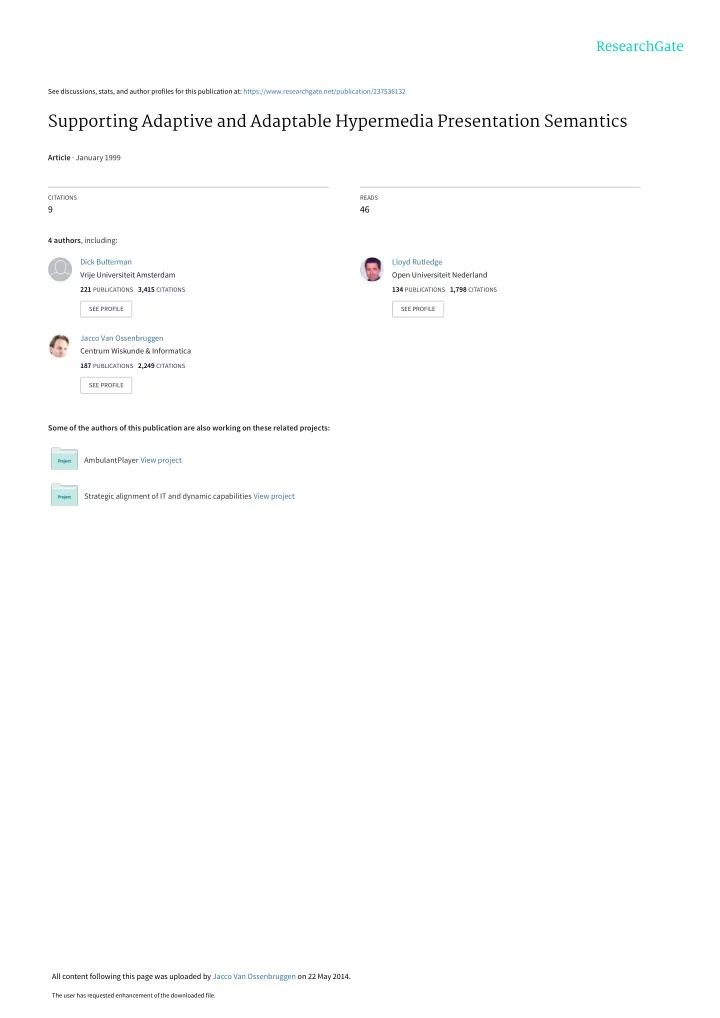

See discussions, stats, and author profiles for this publication at: https://www.researchgate.net/publication/237536132 Supporting Adaptive and Adaptable Hypermedia Presentation Semantics Article · January 1999 CITATIONS READS 9 46 4 authors , including: Dick Bulterman Lloyd Rutledge Vrije Universiteit Amsterdam Open Universiteit Nederland 221 PUBLICATIONS 3,415 CITATIONS 134 PUBLICATIONS 1,798 CITATIONS SEE PROFILE SEE PROFILE Jacco Van Ossenbruggen Centrum Wiskunde & Informatica 187 PUBLICATIONS 2,249 CITATIONS SEE PROFILE Some of the authors of this publication are also working on these related projects: AmbulantPlayer View project Strategic alignment of IT and dynamic capabilities View project All content following this page was uploaded by Jacco Van Ossenbruggen on 22 May 2014. The user has requested enhancement of the downloaded file.
SUPPORTING ADAPTIVE AND ADAPTABLE HYPERMEDIA PRESENTATION SEMANTICS D.C.A. BULTERMAN, L. RUTLEDGE, L. HARDMAN and J. van OSSENBRUGGEN* CWI: Centrum voor Wiskunde en Informatica P.O. Box 94079, 1090 GB Amsterdam, The Netherlands {Dick.Bulterman, Lloyd.Rutledge, Lynda.Hardman}@cwi.nl *Vrije Universiteit Dept. of Math. and Computer Science De Boelelaan 1081a, 1081 HV Amsterdam, The Netherlands jrvosse@cs.vu.nl Abstract. Having the content of a presentation adapt to the needs, resources and prior activities of a user can be an important benefit of electronic documents. While part of this adaptation is related to the encodings of individual data streams, much of the adaptation can/should be guided by the semantics in and among the objects of the presentation. The semantics involved in having hypermedia presentations adapt can be divided between adaptive hypermedia , which adapts autonomously, and adaptable hypermedia , which requires presentation- external intervention to be adapted. Understanding adaptive and adaptable hypermedia and the differences between them helps in determining the best manner with which to have a particular hypermedia implementation adapt to the varying circumstances of its presentation. The choice of which type of semantics to represent can affect speed of the database management system processing them. This paper reflects on research and implementation approaches toward both adaptive and adaptable hypermedia and how they apply to specifying the semantics involved in hypermedia authoring and processing. We look at adaptive approaches by considering CMIF and SMIL. The adaptable approaches are represented by the SGML-related collection of formats and the Standard Reference Model (SRM) for IPMS are also reviewed. Based on our experience with both adaptive and adaptable hypermedia, we offer recommendations on how each approach can be supported at the data storage level. Keywords: adaptive hypermedia, adaptable hypermedia, CMIF, SMIL, HyTime, DSSSL, SRM. 1 INTRODUCTION A hypermedia presentation is a structured collection of hypermedia objects. Each object can be considered to be a static element, or it can be an element that individually or in concert with other objects, has its presentation tailored to the needs of the user. Such tailoring can be based on resource constraints (such as bandwidth), but they could also be tailored to the semantic needs of the user. In this paper adaptive hypermedia is hypermedia that adapts autonomously; that is, they can provide alternatives of individual parts of a presentation under varying circumstances based on directives contained in the presentation definition. This contrasts Database Semantics 8 Submission Page 1 of 20
with adaptable hypermedia , in which a definition of a single abstract presentation is adapted by use of directives that are external to the base presentation’s definition. Both types of adaptation in hypermedia typically account for varying circumstances including user characteristics, system characteristics and intent of the presentation when processed for the user. Different approaches for making hypermedia adapt have been taken by a number of standards and research initiatives. Each approach applies its own distinction between adaptive and adaptable semantics and how they are processed into interaction with the user. Typically adaptable hypermedia is more versatile than adaptive hypermedia but it requires a more complex processing activity to support presentation transformation. This paper contrasts adaptive and adaptable hypermedia. In section 2, we present an overview of existing approaches to supporting adaptive behavior. In section 3, we consider adaptable hypermedia. In section 4, we consider the relative merits of both approaches and discuss the processing support required for implementing adaptive and adaptable presentations efficiently. Section 5 provides closing comments. 2 ADAPTIVE APROACHES Adaptive presentation control, in which the adaptation occurs autonomously in the context of the source presentation, is the dominant form of adaptation. This section provides background information on current adaptive approaches and then give examples of how two related formats (CMIF and W3C’s SMIL) implement adaptive control. 2.1 A SURVEY OF ADAPTIVE APPROACHES The basic problem that adaptive presentations try to solve is the alteration of the presentation’s content to meet the needs of the user. At a low level of detail, this involves changing the representation of a piece of data by substituting a low-quality version of an object for a high-quality (and high-bandwidth) version at data access time. This approach typically falls under the heading of quality of service adaptivity. It will not be considered in detail in this paper, since the processing of alternatives is not driven by semantics but by syntax. An intuitive approach to supporting multiple semantic encodings in a presentation is to define separate projections for each composite presentation, each of which could be configured for the alternatives available. If, for example, we wanted to support a multi- lingual presentation, we could generate one complete projection for the Dutch version of the presentation and another one for the English version. This approach is also not treated in detail, since it is an example of simple presentation substitution rather than presentation adaptivity. There are several ways that adaptive content can be added to a presentation. These fall into two categories: programming-based and declarative. Programming-based control is perhaps the most obvious form of adaptivity control. At its heart is the notion of providing a program or script-based directives within the document that analyze the runtime situation and ‘does the right thing’ for each data request issued. (In this section, Database Semantics 8 Submission Page 2 of 20
Recommend
More recommend